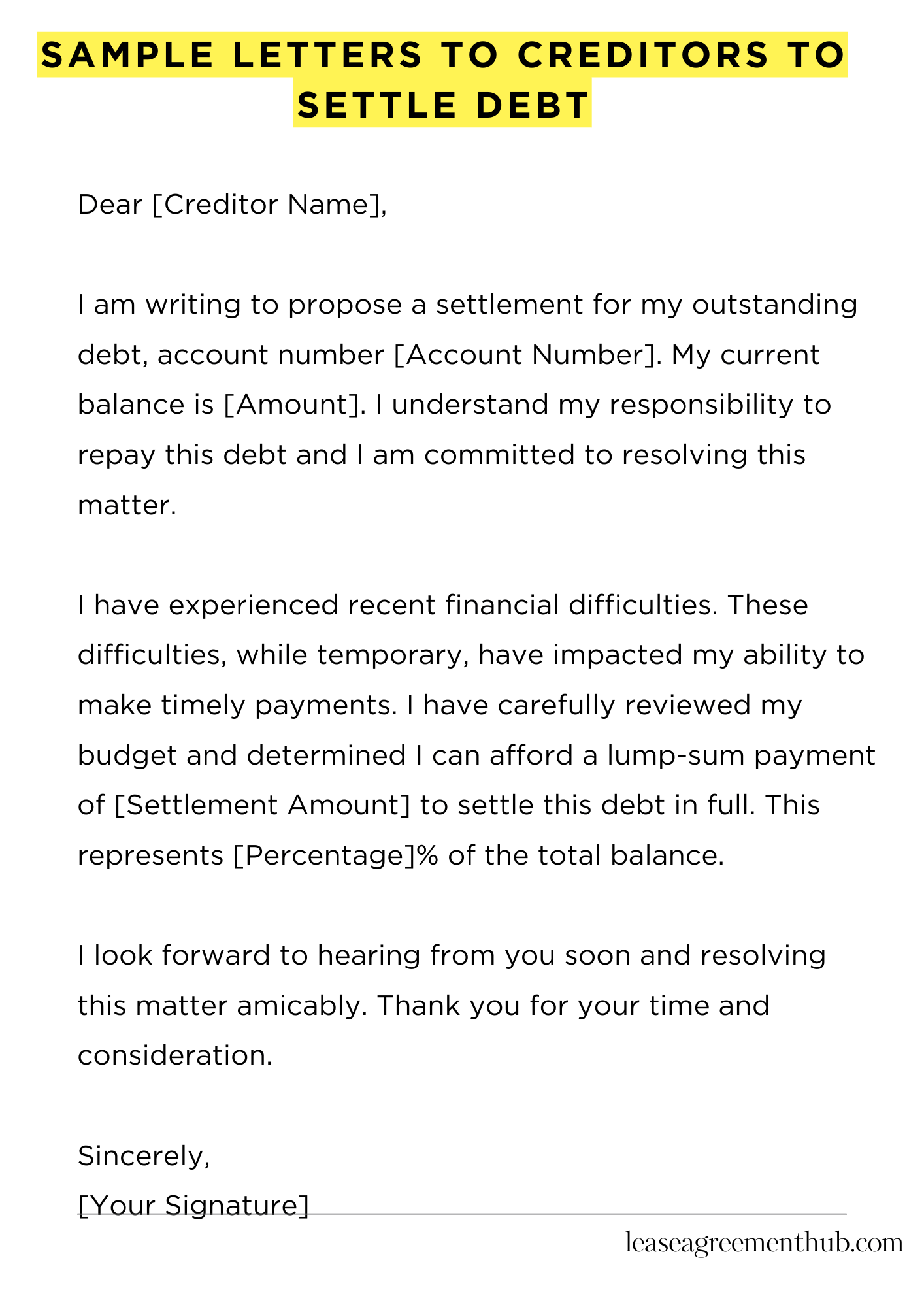Facing overwhelming debt? Sample letters to creditors help you negotiate lower settlements. They’re pre-written templates to help you communicate your financial situation effectively.
This article provides several examples. These are ready-to-use templates. You can adapt them to your specific situation. They make writing your own letter much easier.
We’ll show you exactly what to include. You’ll find various letter formats. We hope you can resolve your debt problems.
Sample Letters to Creditors to Settle Debt
[Your Name]
[Your Address]
[Your Phone Number]
[Your Email Address]
[Date]
[Creditor Name]
[Creditor Address]
Dear [Creditor Name],
I am writing to propose a settlement for my outstanding debt, account number [Account Number]. My current balance is [Amount]. I understand my responsibility to repay this debt and I am committed to resolving this matter.
I have experienced recent financial difficulties. These difficulties, while temporary, have impacted my ability to make timely payments. I have carefully reviewed my budget and determined I can afford a lump-sum payment of [Settlement Amount] to settle this debt in full. This represents [Percentage]% of the total balance.
This offer is contingent upon receiving a full release of the debt upon payment. I would appreciate it if you would consider this proposal. Please let me know if this is acceptable or if you would like to discuss alternative payment arrangements.
I look forward to hearing from you soon and resolving this matter amicably. Thank you for your time and consideration.
Sincerely,
[Your Signature]

How to Write Sample Letters to Creditors to Settle Debt
Understanding Your Creditor’s Perspective
Before crafting your missive, consider the creditor’s position. They’re a business, aiming for profitability. A full debt repayment is their ideal outcome. However, recovering some money is often preferable to recouping nothing. This understanding is paramount in formulating a persuasive argument.
Gathering Essential Information
Before you even think about putting pen to paper (or fingers to keyboard!), meticulously gather all pertinent data. This includes account numbers, outstanding balances, and previous payment history. Accurate information is the bedrock of a convincing plea.
Crafting a Compelling Narrative
Your letter isn’t just a request; it’s a carefully constructed narrative. Begin with a concise explanation of your current financial predicament – use language that evokes empathy, but avoid obfuscation or hyperbole. Clearly articulate your proposed settlement plan, highlighting its feasibility.
Structuring Your Settlement Proposal
Present your settlement proposal with crystalline clarity. This should be a detailed breakdown of your payment plan, including the lump sum amount, payment schedule, and any conditions. Specify the timeframe for acceptance of your offer, adding a sense of urgency without being unduly aggressive.
Negotiating for Optimal Terms
Negotiation is an iterative process. Your initial offer might be rejected. Be prepared to counter-offer, demonstrating flexibility while remaining steadfast in your financial limitations. Remember, a successful negotiation often involves reciprocal concessions.
Maintaining Professionalism and Formality
Maintain a professional and respectful tone throughout. Remember, your goal is to reach a mutually acceptable agreement, not to antagonize the creditor. A courteous and well-structured letter significantly increases your chances of a positive outcome. Avoid emotional outbursts; maintain a measured, conciliatory tone.
Documenting Everything Meticulously
After sending your letter, keep meticulous records of all correspondence. This includes copies of your letter, emails, and any subsequent agreements. This documentation safeguards your interests and provides irrefutable proof of your efforts. This is crucial for future referential purposes.
FAQs about sample letters to creditors to settle debt
Negotiating debt settlement can be complex. Using a well-crafted letter is a crucial first step. Below are frequently asked questions to guide you.
What information should I include in a debt settlement letter?
Your letter should clearly state the debt you wish to settle, the creditor’s name and account number, the current balance of the debt, and your proposed settlement amount. It’s also important to include your contact information and a deadline for the creditor to respond. Consider including a brief explanation of your financial hardship, but keep it concise and factual, avoiding emotional appeals.
What is a good way to propose a settlement amount?
Research suggests offering a percentage of the total debt, often between 30% and 50%, though the ideal percentage depends on various factors including the age of the debt, the creditor’s policies, and your financial situation. You might also research average settlement offers for similar debts to provide a reasonable basis for your proposal. Always be prepared to negotiate.
How do I ensure my letter is professional and persuasive?
Maintain a formal tone throughout the letter, avoiding slang or aggressive language. Use clear and concise language, focusing on facts and figures. Proofread carefully for any grammatical errors or typos. A well-organized and professional letter demonstrates your seriousness and increases your chances of a successful negotiation.
What if the creditor rejects my initial offer?
Be prepared for the possibility that your first offer might be rejected. Have a counter-offer ready, and be willing to negotiate. Explain your reasoning clearly and concisely, and reiterate your commitment to resolving the debt. Consider outlining a payment plan to demonstrate your willingness to cooperate.
Where can I find sample letters to help me write my own?
Numerous online resources offer sample debt settlement letters. However, remember that these are templates, and you should always personalize your letter to fit your specific circumstances and the creditor. Using a sample letter as a guide, tailor it to reflect your unique situation and account details to enhance its effectiveness.
Related: